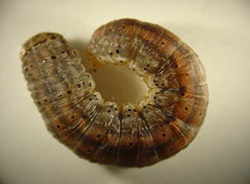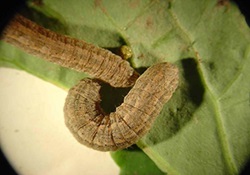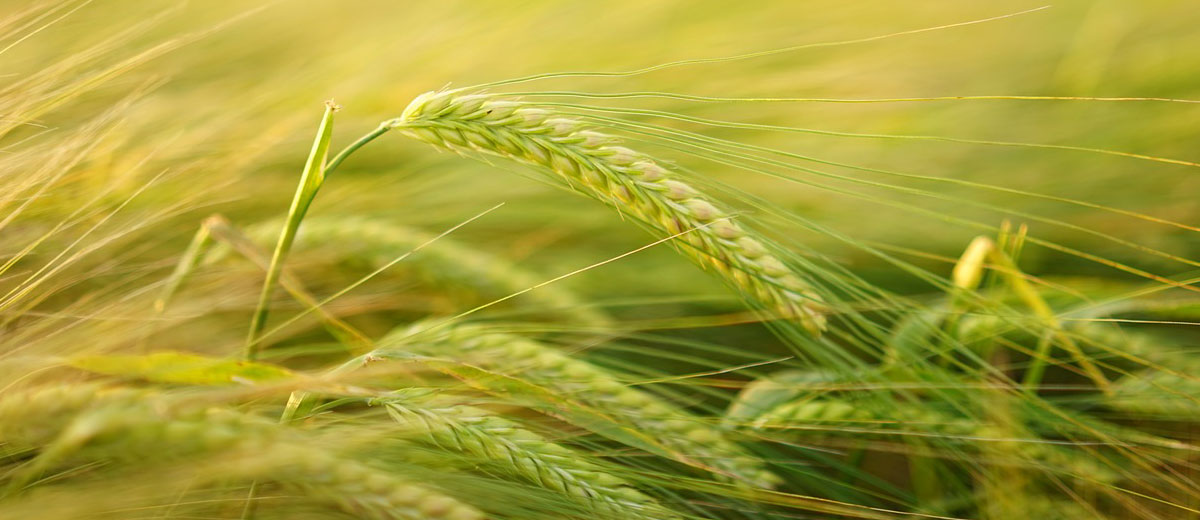Source: Sara Doerksen, AAg, Extension Agrologist Intern, Moose Jaw, Saskatchewan.ca
Cutworms are early season pests that can affect a variety of crops in Western Canada.
There are around 20 different species of cutworm pests in Canada, but, fortunately, only a few of them are capable of causing economic damage in Saskatchewan.
Cutworm is the common name given to the larvae stage of numerous moth species. Only the larvae stage of these species cause damage to crops, with either subterranean (underground), above-ground, or climbing feeding behaviours.

John Capinera, University of Florida,
Bugwood.org)
Signs of cutworms in the field can include notches or holes in foliage; plants that are wilting, falling over, or completely clipped off; and, thin or bare patches. It is important to confirm that the symptoms are caused by cutworms and not by poor emergence or other pest issues such as damping-off disease, which may cause bare patches or wilting.
When scouting, it is important to be able to identify which species of cutworm is in your crop. The different cutworms have diverse habitats and feeding behaviours, and therefore can affect your crop in a variety of ways. The lifecycle timing and length also varies between species with some larvae feeding earlier or later in the growing season than others.

Scouting for cutworms should be done regularly starting early in the spring after plant emergence until approximately mid-July. Dingy and army cutworms both overwinter as larvae and cause most of their damage earlier in the season, whereas pale western and red-backed cutworms overwinter as eggs and need to become larvae to cause crop damage. Cutworms tend to cause damage at hilltops, south-facing slopes, and drier parts of the field, but they may be found in other areas as well.
To scout, carefully search the top one to two inches of soil around the base of damaged plants. Cutworms will move from damaged plants to healthy plants to continue feeding; so, also search for them at the base of healthy plants within or around the outside of the affected patches. The larvae tend to feed during the night and stay underground during the daytime. Even if the pest is not found on plants that show above-ground feeding symptoms, they may be found on or beneath the soil surface.There are various management practices that can be used to control cutworms. Natural enemies of cutworms, including parasitoids and predatory insects, are particularly important for ending multiple year outbreaks. Refer to the Agriculture and Agri-Food Canada’s Cutworm Pests of Crops on the Canadian Prairies for more information on natural enemies.

Cultural control options vary depending on the species of cutworm present. Weed-free uncultivated fields in late summer are less attractive for egg laying for overwintering. Seeding later in the spring or cultivating the soil and keeping it black before seeding can starve cutworms that overwinter; however, the risk of soil erosion has to be taken into account when considering this control option.
If the level of cutworms is above the economic threshold for a specific crop, there are foliar insecticides available to control the pest. It is recommended that pesticides are applied in the late evening when larvae begin feeding so that they come in contact with the spray. For more information on insecticides available for specific crops please refer to the Guide to Crop Protection.

Cranshaw, Colorado State University,
Bugwood.org)
For more information on general and specific cutworm identification and management refer to:
Agriculture and Agri-Food Canada’s Cutworm Pests of Crops on the Canadian Prairies
Agriculture and Agri-Food Canada’s Field Crop and Forage Pests and their Natural Enemies in Western Canada
